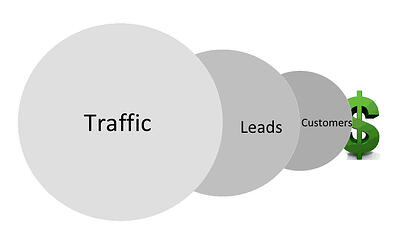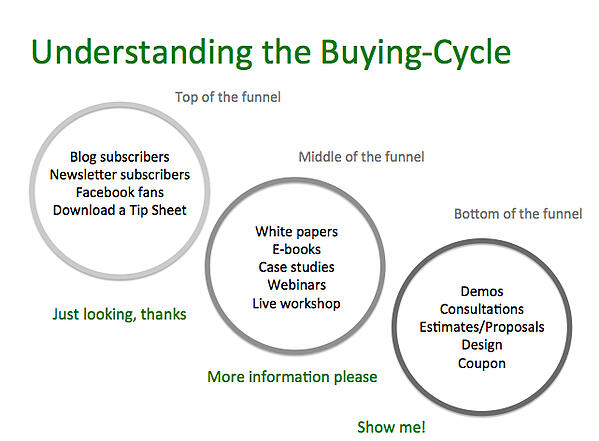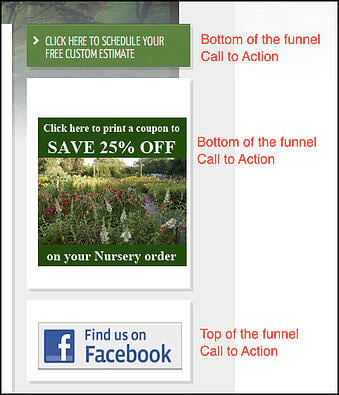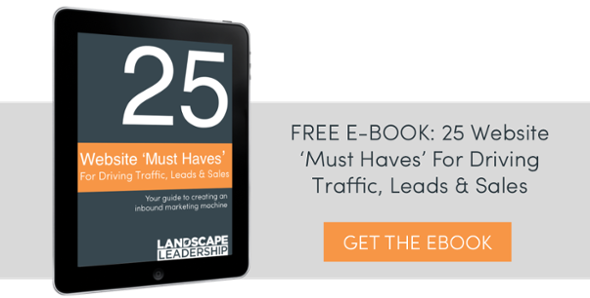Topics: Search Engine Optimization (Seo) Social Media Content Marketing Sales Web Development
Proven Ways Landscaping Company Websites Can Increase Traffic and Generate Qualified Leads
 Author: Chris Heiler
Author: Chris Heiler
This article originally appeared in the October 2012 issue of Turf magazine.
After analyzing hundreds of green industry company websites over the years we have established three distinct stages that most companies are at:
- The company does not have a website
- The company has a basic website, typically 7 to 20 static pages, that is used primarily as an online brochure.
- The company has a website with more than twenty pages, many times with a blog, and the company uses their basic understanding of search marketing and social media to drive traffic to the site.
There is a stage four, of which very few companies in our green industry achieve. These companies separate themselves from the others by using their website as a lead generation machine. These websites are optimized to not only drive traffic, but to generate qualified leads that can be turned into customers.

Think about this: What good does it do if you increase the amount of traffic to your company website each month yet you don’t convert that traffic into leads that your sales team can actually follow up with? You’re leaving money on the table.
Generating leads with your website requires intention--it doesn’t just happen. Your website has to be built with lead acquisition at its core.
In this article we’ll discuss the processes you need to put in place that will increase the amount of visitors to your website, generate qualified leads, and then nurture those leads into customers.
Using inbound marketing to drive traffic to your landscaping company website
Inbound marketing is based on the concept of earning the attention of prospects and making your company more easily found online by producing content your customers value. In contrast, cold-calling, direct mail, radio advertisements, sales fliers and other forms of traditional advertising are considered “outbound marketing".
Inbound marketing is especially effective for small businesses that deal with high-dollar values, long research and buying cycles and knowledge-based products and services. In these areas prospects are more likely to hire companies who demonstrate superior expertise in their industry. Because of this, inbound marketing is an ideal strategy for green industry companies.
Social media, search marketing and content marketing each play a key role in a cohesive inbound marketing strategy, working together to increase traffic to your website. Alone, or operating in silos, each becomes less impactful.
The case for content
Potential customers find your business through the content you create and publish. Whether by reading your blog post or watching your video on YouTube, original content is what generates more traffic to your landscaping company website and, ultimately, generates qualified leads and new customers.
Your business is fighting for the limited attention of your customers and prospects. You are also going head to head with your competitors fighting for the attention of the search engines like Google and Bing. Creating original and compelling content on a regular basis is how you win this battle for attention, yet companies are ignoring this opportunity.
A very small number of companies in our industry blog on a regular basis (three to four times per month). Yet studies have shown that blogging results in a 55% increase in website visitors, and, companies that blog have 97% more inbound links than those that don’t (source: HubSpot, State of Inbound Marketing Lead Generation Report, 2010).
Your content feeds your social media. It’s what gives your website a boost in search rankings. Picture a delicious cheeseburger in your hands: Your content is the meat. Social media is the tasty cheese on top and the bun is your SEO (search engine optimization). Without the meat--your content--your burger becomes nothing but tasteless bread and cheese.
So you have traffic...now what?
Let’s first differentiate between “prospects” and “leads” as they relate to inbound marketing. At Landscape Leadership we consider prospects to be the visitors to a website. Some of these visitors, or prospects, will be interested in your products and services to varying degree while others will not. Those interested will dig deeper into your site seeking more relevant, helpful information. Those not interested will bounce. The individual identity of these prospects is unknown.
Your objective is to turn these interested prospects into leads.
A prospect becomes a lead when the individual agrees to exchange their identity and contact information for something of value on your website. For a lawn care company, this could be as simple as a coupon exchanged for a full name and email address. Once this equal-value transaction has been completed, that prospect becomes a lead in your sales funnel.
Your sales funnel

Every company, every product and every service has a unique buying cycle. The buying cycle for lawn care services will differ dramatically from that of buying a new tree or even installing a completely new landscape.
Each prospect that visits your website is at a unique point in the buying cycle. Most companies don’t understand this or they ignore it. This is your opportunity to separate yourself from your competitors.
Your website is a sales funnel with each visitor at a different point in your funnel, or buying cycle. It is your job to, first, convert these prospects into leads, and second, move them further down the sales funnel. The sales funnel consists of three types of leads:
- Top of the Funnel (TOFU)- Prospects are not typically ready to buy, they are simply looking for more information and conducting research.
- Middle of the Funnel (MOFU)- Prospects are more serious and actively looking for more information to aid their decision making process.
- Bottom of the Funnel (BOFU)- Prospects are ready and eager to make a purchasing decision.
99% of the landscaping company websites we analyze are only optimized for bottom of the funnel (BOFU) prospects.
This is a huge mistake considering the majority of a website’s visitors are not even close to making a purchasing decision. 75 to 90% of a website's visitors are typically in fact-finding mode--they are not ready to pick up the phone and call you...yet.
This is especially true in the landscaping industry when buying cycles can be extremely long. That soon-to-be homeowner who is breaking ground on a new home in three months is more than likely months, maybe even years, away from deciding on a lawn care provider. But she is on your website right now conducting research. What are you going to do about it?
Being intentional
Leads don’t just magically appear. They are created by implementing an intentional lead-generation process.

This two-part process begins with a strong call-to-action (CTA) which leads to a unique landing page optimized for conversion.
The most common CTAs we see on green industry websites encourage people to click through to a “Contact Us” page or to a questionnaire page (both BOFU CTAs). Others we see are the common “subscribe to our newsletter” or “Follow us on Facebook”, which are very top of the funnel (TOFU) call-to-actions.
The problem with this approach should be obvious: These websites are not optimized for the majority of visitors who are not at the very top or very bottom of the sales funnel.
The example shown to the right illustrates a good use of CTA’s on a website, except the site is missing a strong MOFU call-to-action. (On a side note, “Follow us on Facebook” is not an ideal TOFU call-to-action because existing customers are more likely to follow your company on Facebook than a brand new visitor to your website who is unfamiliar with your business. Also, you're really only collecting a Facebook follower, not a true lead.)
Along with the strong BOFU “coupon” and “free estimate” call-to-action, we would recommend adding a better TOFU call-to-action like “Subscribe to our blog” and a strong MOFU call-to-action like an informative case study or whitepaper that a visitor could download.
With this approach the website would appeal to more visitors and generate more leads, each at a different point in the buying cycle.

Each CTA on your website should lead to a unique landing page optimized to convert the prospect into an actual lead for your company. In the example above from our website, we offer a free infographic for download (TOFU call-to-action). This CTA button leads to a landing page focused on converting the visitor to a lead by implementing a simple web form. This is a standard best practice that can easily be integrated into any website.
Picture that delicious cheeseburger again with the melted cheese and toasted bun in your hand. That’s your inbound marketing program--your content, social media and SEO--driving loads of new prospects to your website. Now imagine yourself actually tasting that cheeseburger and how satisfying it is to your taste buds. Turning those prospects into actual leads and customers with an intentional lead-acquisition process will be even more satisfying to your bottom line.





